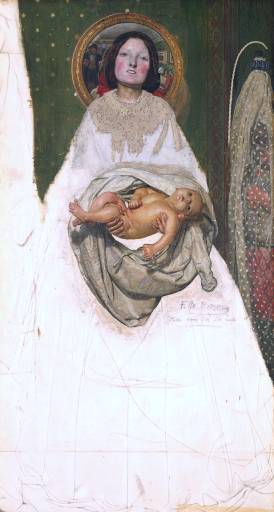- Take your Son, Sir!
Infobox Painting

backcolor=#FBF5DF
painting_alignment=right
image_size=200px
title=Take your son, Sir!
artist=Ford Madox Brown
year= 1851-6
type=Oil on canvas
height=381
width=705
height_inch=
width_inch =
diameter_cm =
diameter_inch =
city= London
museum= Tate Gallery"Take Your Son, Sir!" (1851-6) is an unfinished painting by
Ford Madox Brown which depicts a woman showing her newborn son to its father. She is offering her baby towards the viewer of the painting, who is implicitly equated with the father - seen in the mirror behind, opening his arms to receive the baby. The mirror also forms a halo behind the mother's head, and the pattern on the wallpaper suggests the starry heavens. Brown's principal influence wasJan van Eyck 's painting the Arnolfini Marriage Portrait, recently acquired by the National Gallery. The mirror resembles the circular mirror in van Eyck's painting, which reflects an image of the artist looking at the couple in the image.The woman is wearing
crinoline s, which expand to cover the whole of the lower part of the painting. Brown has left this part incomplete, roughly squaring up and sketching the dress in outline. The title is written on the unfinished dress, underneath the child at the right.It is not known why Brown failed to complete the painting, but he seems to have worked on it intermittently throughout his life.
Interpretations
There are two principal interpretations of the picture. Most critics see it as an image of a wife offering the child to her husband, an interpretation supported by the sacred symbolism and by the fact that Brown depicted his own wife and their new son. Some commentators, however, interpret it as more confrontational image, in which an abandoned mistress presents her baby to its father. [ [http://www.tate.org.uk/servlet/ViewWork?workid=1608 Tate Gallery Collection, Take your Son, Sir'!1851-92] ]
The art historian
Marcia Pointon has argued that the painting is deliberately paradoxical, playing on the conflict between new life and death. She suggests that the portrayal of the baby is influenced by medical images offetus es surrounded by viscera within the body of woman, and that the woman's glazed, white and emaciated features suggest death. [Pointon, Marcia, "Interior Portraits: Women, Physiology and the Male Artist", "Feminist Review", No. 22 (Spring, 1986), pp. 5-22]Notes
Wikimedia Foundation. 2010.
